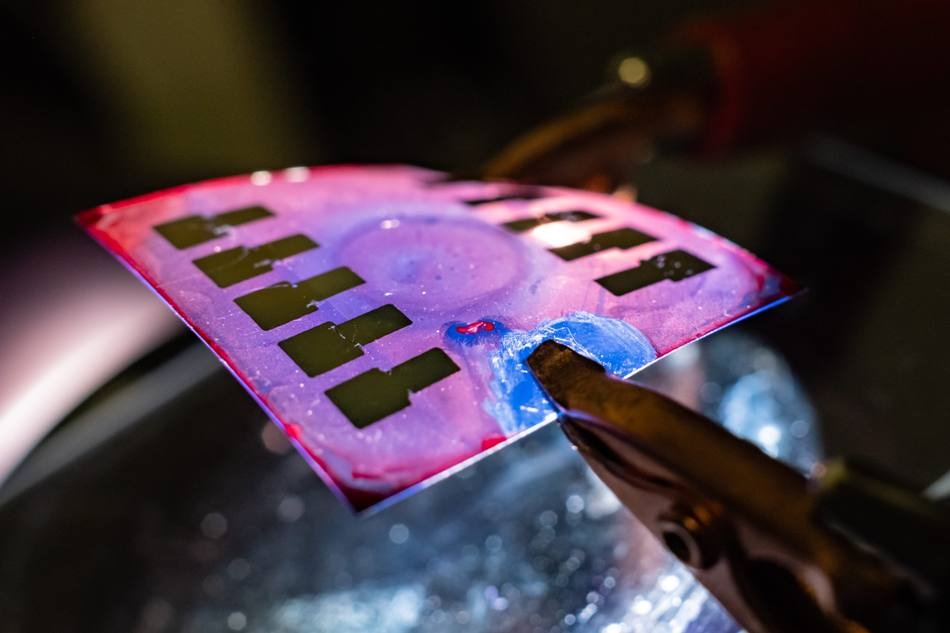Nov 8 2018
Organic solar cells that can be printed or painted on surfaces are more and more efficient, and at present show promise for integration into applications like clothing that also entail them to be flexible.
 Rice scientists have developed flexible organic photovoltaics with a chemical additive that mitigates the material’s brittle qualities without losing efficiency. (Photo by Jeff Fitlow)
Rice scientists have developed flexible organic photovoltaics with a chemical additive that mitigates the material’s brittle qualities without losing efficiency. (Photo by Jeff Fitlow)
Flexible organic photovoltaics developed by the Rice University lab of chemical and biomolecular engineer Rafael Verduzco could be useful where constant, low-power generation is adequate.
Verduzco and his team integrate a network of elastic additives to reduce the brittleness of the electrically active material with little to no loss of current flow.
The research has been published in the American Chemical Society journal Chemistry of Materials.
Organic solar cells depend on carbon-based materials such as polymers, as opposed to hard, inorganic materials like silicon, to trap sunlight and change it into current. Organics are also thin, semitransparent, lightweight, and inexpensive. While middle-of-the-road, commercial, silicon-based solar cells perform at around 22% efficiency—the amount of sunlight transformed into electricity—organics outperform at about 15%.
“The field has been obsessed with the efficiency chart for a long time,” Verduzco said. “There’s been an increase in efficiency of these devices, but mechanical properties are also really important, and that part’s been neglected.
“If you stretch or bend things, you get cracks in the active layer and the device fails.”
Verduzco said one method to solving the brittle problem would be to look for polymers or other organic semiconductors that are naturally flexible; however, his lab chose another tack. “Our idea was to stick with the materials that have been carefully developed over 20 years and that we know work, and find a way to improve their mechanical properties,” he said.
Instead of making a mesh and pouring in the semiconducting polymers, the Rice scientists blended in sulfur-based thiol-ene reagents. The molecules mix with the polymers and then crosslink with each other to deliver flexibility.
The process is not without a challenge, as very little thiol-ene leaves the crystalline polymers susceptible to cracking under stress, while too much diminishes the material’s efficiency.
Testing helped the lab discover its Goldilocks Zone.
If we replaced 50 percent of the active layer with this mesh, the material would get 50 percent less light and the current would drop. At some point, it’s not practical. Even after we confirmed the network was forming, we needed to determine how much thiol-ene we needed to suppress fracture and the maximum we could put in without making it worthless as an electronic device.
Rafael Verduzco, Chemical and Biomolecular Engineer, Rice University Lab.
At around 20% thiol-ene, they discovered that cells kept their efficiency and gained flexibility. “They’re small molecules and don’t disrupt the morphology much,” Verduzco said. “We can shine ultraviolet light or apply heat or just wait, and with time the network will form. The chemistry is mild, fast and efficient.”
The subsequent step was to stretch the material. “Pure P3HT (the active polythiophene-based layer) started cracking at about 6 percent strain,” Verduzco said. “When we added 10 percent thiol-ene, we could strain it up to 14 percent. At around 16 percent strain we started seeing cracks throughout the material.”
At strains greater than 30%, the material flexed quite well but became unusable as a solar cell. “We found there’s essentially no loss in our photocurrent up to about 20 percent,” he said. “That seems to be the sweet spot.”
Damage caused by strain impacted the material even when the strain was released. “The strain impacts how these crystal domains pack and translates to microscopic breaks in the device,” Verduzco said. “The holes and electrons still need paths to get to the opposite electrodes.”
He said the lab hopes to try various organic photovoltaic materials while attempting to make them more stretchable with less additive for larger test cells.
Rice graduate student Jorge Wu Mok is the paper’s lead author. Co-authors are Rice graduate student Zhiqi Hu, undergraduate Changxu Sun and alumnus Isaiah Barth; summer researchers Rodrigo Muñoz and Joshua Jackson of Rice and Houston Community College; research scientist Tanguy Terlier of Rice’s Shared Equipment Authority; and Kevin Yager of Brookhaven National Laboratory, Upton, N.Y.
The study was supported by the National Science Foundation, the Welch Foundation for Chemical Research and the Department of Energy Office of Science Facilities.
Stretchy solar cells a step closer